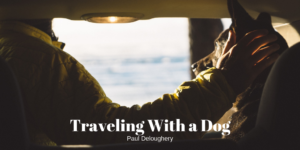Traveling With a Dog
Search
Recent Post

What to Expect From Airlines in 2019

Vacation Shaming

Traveling With Children

Traveling With a Dog

A couple of weeks ago, my wife and I decided to visit the Oregon coast. We live in Phoenix, Arizona. We had recently adopted a six-month-old dog (Sean) from a shelter two weeks earlier. This raised the question: What would we do with Sean?
Boarding him seemed cruel. He had spent his early months homeless and was still trying to figure out if he could trust us, humans. Also, we didn’t want him to think we were giving him back.
Flying on an airplane was not an option for us because his size would mean that we would be shipping him like a package and we would not necessarily be on the same plane as him. There was going to be a 4-hour layover, and we would not even be able to see him during this time. We also considered the risk of him dying on the plane. According to an article in the Guardian, “only” 26 animals died while being transported on planes in 2016, a rate of 0.5 per 10,000 animals transported. That’s a relatively small percentage. But it’s way bigger than the risk of us humans dying on a plane ride (1 in 11 million).
We wanted to take our dog along for the journey so he could be part of the family. But how? We decided to rent a car to keep the miles off our Jeep. Enterprise is great because you don’t pay for the miles.
We are making food for him (rather than feeding him the unhealthy grain-based dog foods). We brought two days worth of pre-prepared food (frozen) in a cooler and then thawed it out as necessary. By the way, our dog seems to thrive on a mixture of brown rice, zucchini, beef and/or chicken breast (or a combination of beef and chicken), and a pinch of salt.
We don’t have a cage for Sean. We used a harness and leash for when he was in a high-traffic area or near other dogs. At rest stops on the way, we would use the leash to guide him far away from other dogs, and then take him off leash so he could run freely. We would play “fetch” with him and just run back and forth so we all got exercise.
In the car, we had a cover for the back seat and plenty of toys. This was his sanctuary. It took him no time at all to get into the routine of going to sleep while we were driving and wake up whenever we stopped. I didn’t think a dog could sleep that long, but it was probably like I did as a child. Sleeping was my way of making long trips go faster.
Here are some other general suggestions:
- Start preparing long before you, and your furry friend takes a step out of the front door. Research your destination before planning your trip. Reviewing travel forums and the hotels’ websites before you book your stay can help avoid any surprises when you arrive.
- Check if there are certain health regulations for animals, whether or not the hotel accommodates all animals, where the nearest veterinary clinic is, and much more. If you are flying, you will want to check what the rules and restrictions are when bringing your animal on a flight.
- Create a list of packing essentials. Comfortable carriers can make a world of difference for animals, whether they’re driving or flying. You will also want to make sure they have something familiar with them in their cage (if you use one) to relax them during the journey.
- If you are driving with your pet, you will want to make sure you pack a travel size kit of food, water, medications, treats, toys, and veterinary’s contact information. You will want to pack enough food and water to last your animal a couple of days more than what the trip is scheduled for. There can always be unforeseen circumstances that may delay your return home.
- When it’s time to head to the airport or into the car for your road trip, make sure they have time to relieve themselves before entering the vehicle. Then take some time to calm your pet into the car.
Traveling with your pet does not have to be any more stressful than it is with the rest of the family. Just take the necessary time, do research, plan, and prepare for a fun, relaxing vacation.




